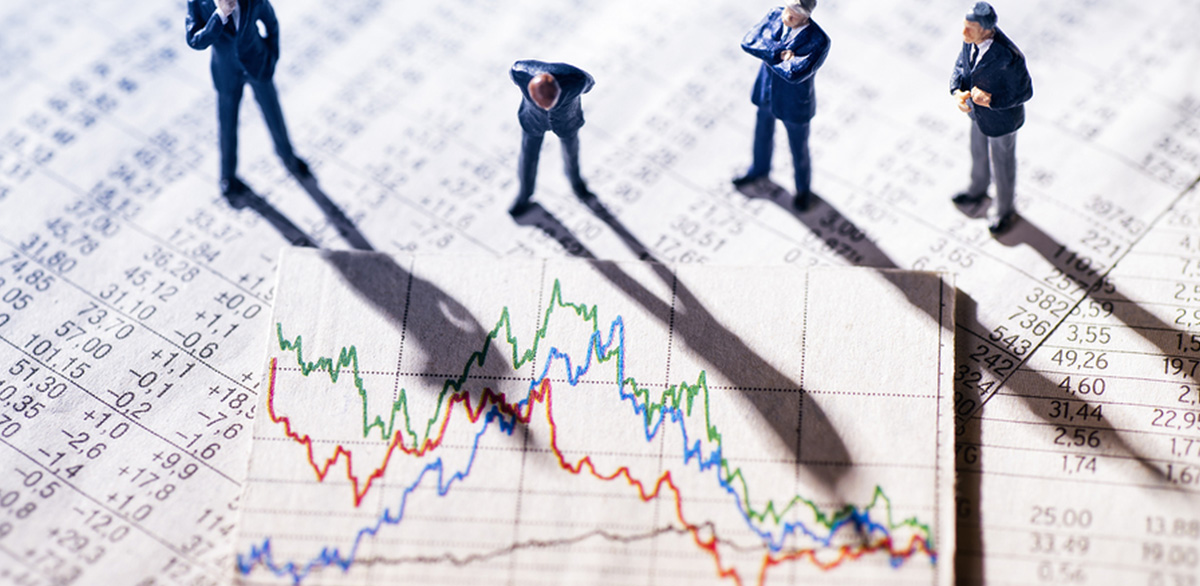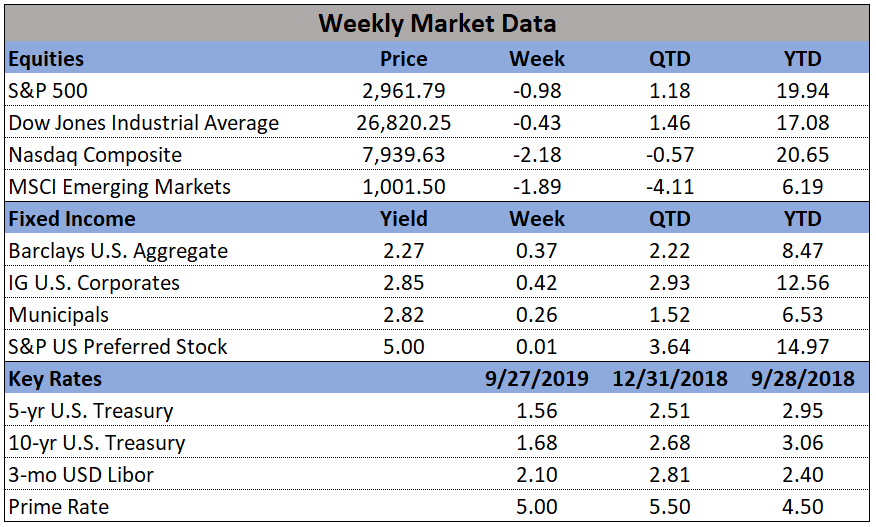In the markets:
U.S. Markets: The major U.S. indexes ended higher after another week in which trade headlines held sway over sentiment. News of a preliminary U.S.-China trade deal lifted the “Big Three”, the Dow Jones Industrial Average, the S&P 500 large cap index, and the technology-heavy NASDAQ Composite to new record highs. The Dow Jones Industrial Average added 120 points to close at 28,135 - a gain of 0.4%. The NASDAQ added 0.9% and the S&P 500 rose 0.7%. The small cap Russell 2000 and mid cap S&P 400 underperformed the larger cap indexes, rising 0.3% and 0.1%, respectively.
International Markets: Major international markets were a sea of green as trade tensions appeared to de-escalate. Canada’s TSX rose a slight 0.04%, while the United Kingdom’s FTSE rallied 1.6% aided by Boris Johnson’s electoral victory. On Europe’s mainland, France’s CAC 40 added 0.8%, Germany’ DAX rose 0.9%, and Italy’s Milan FTSE gained 0.6%. Asian markets were especially strong. China’s Shanghai Composite jumped 1.9% and Japan’s Nikkei surged 2.9%. As grouped by Morgan Stanley Capital International, emerging markets rose 3.1% and developed markets added 1.4%.
Commodities: Precious metals rebounded last week with Gold rising 1.1% to finish the week at $1481.20 an ounce and Silver adding 2.5% to close at $17.01. Energy rose for a second consecutive week. West Texas Intermediate crude oil gained 1.5% closing at $60.07 per barrel. Copper, viewed by some analysts as a barometer of global economic health due to its wide variety of industrial uses, rose for a fourth consecutive week by tacking on 2.1%.
U.S. Economic News: The number of Americans seeking first time unemployment benefits soared to a more than two-year high last week but analysts downplayed it, stating the spike was most likely tied to a later than usual Thanksgiving holiday season instead of actual rising layoffs. Initial jobless claims jumped by 49,000 to a seasonally-adjusted 252,000 in the first week of December. The reading was its highest since September of 2017. Economists had estimated new claims would total just 220,000. Jobless claims often gyrate during the long holiday season that starts after Thanksgiving. Laid-off workers wait longer to file claims, unemployment offices are closed more often and companies add and drop temporary workers. The more stable monthly average of new claims, by contrast, rose a much smaller 6,250 to 224,000. That reading is more likely to reflect the underlying level of jobless claims. Continuing claims, which counts the number of people already collecting unemployment benefits, fell by 31,000 to 1.67 million. That number is reported with a one-week delay.
Americans paid more for energy, healthcare and rent last month, lifting the rate of inflation to its highest level in a year. The Bureau of Labor Statistics reported its Consumer Price Index rose 0.3% last month. Economists had estimated just a 0.2% advance. The recent spike lifted the increase in the cost of living over the past year to 2.1%. That’s its highest level since November 2018. Still, economists note, inflation remains low by historical standards. Core CPI, which strips out the volatile food and energy categories, increased by 0.2% last month. The annual increase in the core rate remained unchanged at 2.3%. The Federal Reserve’s preferred inflation gauge, the Personal Consumption Expenditures (PCE) Index remains significantly lower than the CPI measure. The PCE index is up just 1.3% in the 12 months ended in October. Economists note that even if prices rise faster than expected, the Federal Reserve is comfortable with an inflation rate above 2% after years of undershooting its target. Richard Moody, chief economist at Regions Financial stated that “the Fed has signaled it will be comfortable letting inflation run ahead of their target, which means it will be even longer before inflation again becomes a material concern.”
At the wholesale level, the government reported the cost of goods and services remained flat in November indicating that inflation is likely to remain tame in at least the near future. Economists had predicted a 0.2% increase. Wholesale inflation has risen just 1.1% over the past year, marking its lowest rate since 2016. The yearly rate had touched a seven-year high of 3.4% just over a year and a half ago. In the details, the cost of services declined 0.3%, offsetting a 0.3% increase in the price of goods. Core PPI was also flat last month. That measure of inflation’s annual rate slipped to 1.3% - its smallest year-over-year increase in three years. Michael Pearce, senior U.S. economist at Capital Economics wrote, “Overall, the November PPI figures underline that price pressures in the inflation pipeline are still easing. Against that backdrop, the Fed is going to remain on hold a lot longer than just through the end of 2020.”
Sales at U.S. retailers rose only slightly in November leading to concerns among analysts of a possibly poor holiday shopping season. The Commerce Department reported retail sales edged up just 0.2% in November. Economists had expected a 0.5% increase. One possible reason for the shortfall could be that the late Thanksgiving this year pushed the first big weekend of holiday spending into December. In the details of the report, internet-based retailers fared the best, as well as electronics and appliances retailers. However, the rest of the retail industry lagged behind. Still, analysts note that a strong 2019 holiday season may be in store. They note the labor market is robust, unemployment is low, stocks are at record highs, and consumer confidence has rebounded after a late-summer lull.
The Fed statement released during the week gave a more upbeat view of the economy than has been recently the case. Fed Chair Jerome Powell stated he doesn’t expect to raise interest rates again for at least another year. At the Fed’s final policy meeting of the year, the board voted unanimously to leave its benchmark rate in the range of 1.5-1.75%. It was the first vote without a dissent in the last five meetings. The central bank also signaled its intention to leave interest rates unchanged through the end of 2020. Economist Andrew Hollenhorst of Citibank said in a note to clients, “Powell was very explicit in guiding that only a ‘persistent, significant’ rise in inflation would lead him to support hikes.” The Fed had cut U.S. interest rates in three successive meetings starting in July to support the economy in the midst of a trade war with China. Senior Fed officials believe the series of rate cuts has helped stabilize the economy and lower the odds of recession.








